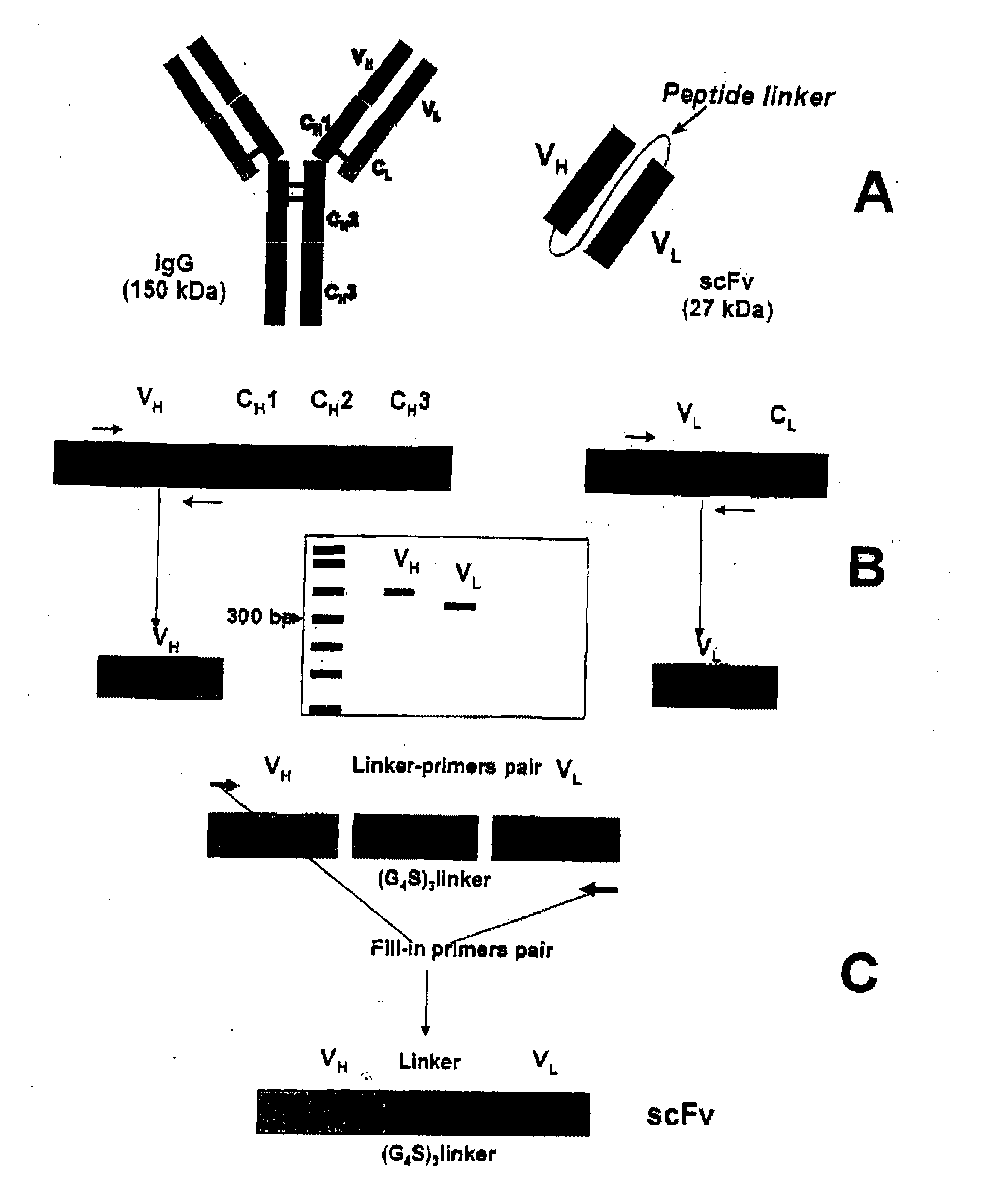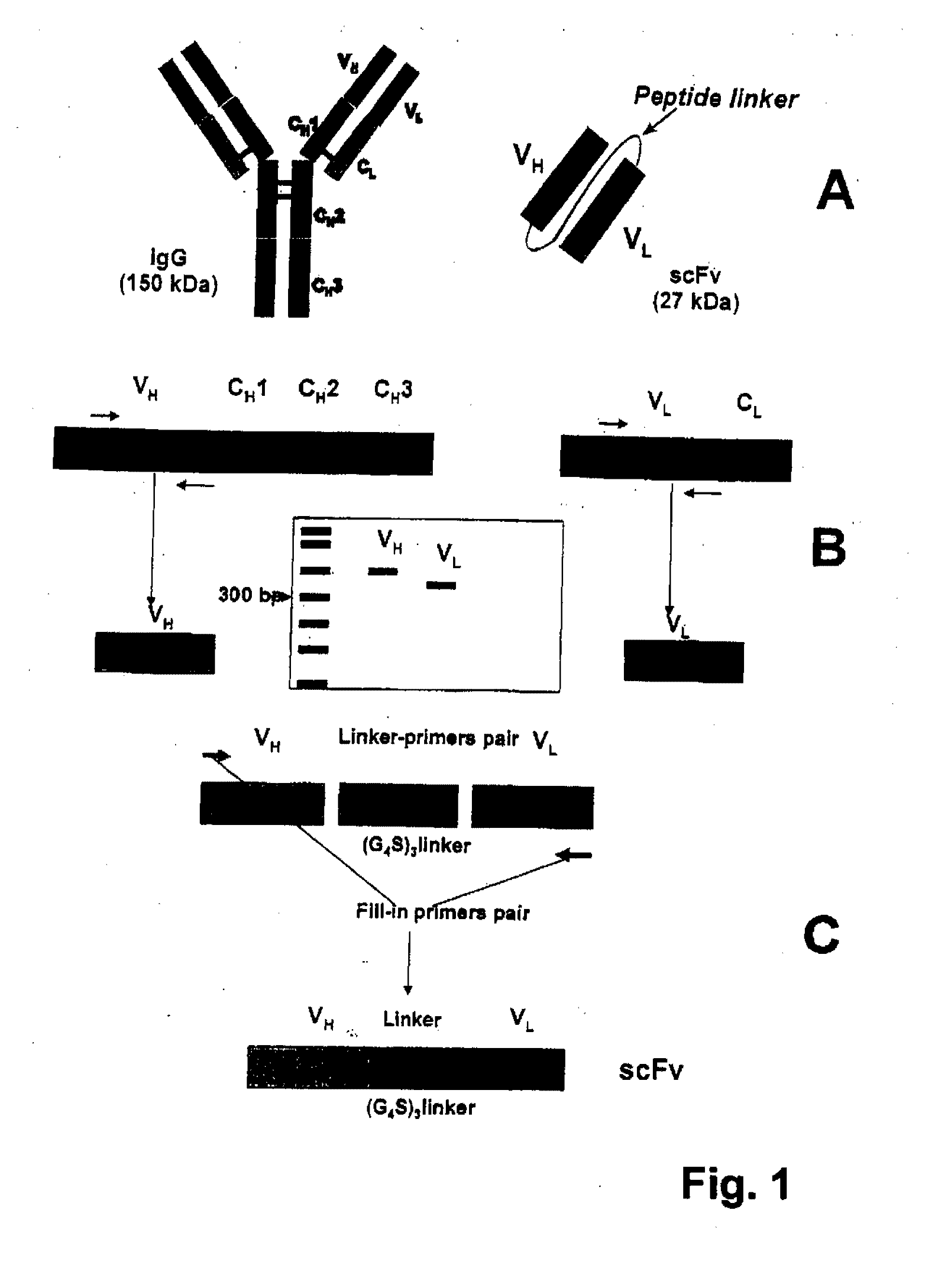Targeting recombinant therapeutics to circulating red blood cells
a technology of circulating red blood cells and recombinant therapeutics, which is applied in the direction of antibody medical ingredients, extracellular fluid disorders, peptide/protein ingredients, etc., can solve the problems of drug elimination, side effects, and most drugs not circulating for a sufficient time in the bloodstream, and achieves a more effective and safe management of thrombosis
- Summary
- Abstract
- Description
- Claims
- Application Information
AI Technical Summary
Benefits of technology
Problems solved by technology
Method used
Image
Examples
example 1
Generation of a Single Chain Antigen-Binding Domain (scFv) Molecule
[0090]Generation of a single chain antigen-binding domain (scFv) molecule is illustrated in FIG. 1. scFvs are generated in accordance with the teachings herein, as well as those of Spitzer, et al. (Mol. Immunol. 2003, 40:911-919). Total RNA of a hybridoma cell line is isolated (e.g., by RNeasy, Qiagen, Velencia, Calif.). RNA is reverse transcribed, e.g., using the SMART™ technology (Clontech, Palo Alto, Calif.) employing known primers (e.g., those of Dübel, et al. (J. Immunol. Methods 1994, 175:89-95)). The resulting heavy (VH) and light (VL) chain variable cDNA fragments are subcloned into a suitable plasmid, e.g., the pCR®2.1-TOPO® (Invitrogen, Carlsbad, Calif.). Plasmids are then transfected into E. coli. VH and VL chains are then isolated by conventional techniques, e.g., agarose gel column or gel electrophoresis.
[0091]VH and VL chains are combined with a suitable linker, e.g., a (G4S)3 linker (SEQ ID NO: 2) Böld...
example 2
Generation of a Pro-Drug scFv Fusion Protein
[0092]An scFv (RBC epitope binding) is prepared as described in Example 1. A thrombin cleavage site (PR, i.e., Pro-Arg) is cloned into a (S4G)2AAA (SEQ ID NO: 1) linker peptide (internally, or at its N- or C-terminus), and the resulting peptide is used to link the VL domain of the scFv to the low molecular weight single chain urokinase-like plasmin activator. The thrombin cleavage site (PR) cloned in the linker peptide allows the release of single chain urokinase-like plasmin activator from RBC / fusion protein complex during clot formation.
example 3
Generation of a Non-Releasable scFv-Plasminogen Activator (Upa) Fusion Protein
[0093]Recombinant anti-Ter119scFv [anti-GPA (glycophorin A associated protein)] was produced as described in Example 1. A plasmid (pcDNA3, (Dr. Atkinson, Washington University, St. Louis) encoding Ter119-scFv (SEQ ID NO: 4) was utilized. Primers were designed via conventional techniques, and two PCR amplifications were performed. The first amplification was of DNA encoding the scFv, adding DNA encoding the (S4G)2AAA (SEQ ID NO: 1) linker to its C terminus. The second amplication was of DNA encoding uPA (SEQ ID NO: 5). Both amplified segments were ligated together into the pMT / BipN5H isA plasmid (Invitrogen), with the Ter-119scFv portion N-terminal to the uPA sequence.
[0094]Ter119scFv-uPA (SEQ ID NO: 6) was expressed in pMT / BipN5H isA plasmid in Drosophila S2 cells (Drosophila DS2 expression System (Invitrogen)).
PUM
| Property | Measurement | Unit |
|---|---|---|
| diameter | aaaaa | aaaaa |
| circulation time | aaaaa | aaaaa |
| time | aaaaa | aaaaa |
Abstract
Description
Claims
Application Information
 Login to View More
Login to View More - R&D
- Intellectual Property
- Life Sciences
- Materials
- Tech Scout
- Unparalleled Data Quality
- Higher Quality Content
- 60% Fewer Hallucinations
Browse by: Latest US Patents, China's latest patents, Technical Efficacy Thesaurus, Application Domain, Technology Topic, Popular Technical Reports.
© 2025 PatSnap. All rights reserved.Legal|Privacy policy|Modern Slavery Act Transparency Statement|Sitemap|About US| Contact US: help@patsnap.com



